Related Research Articles
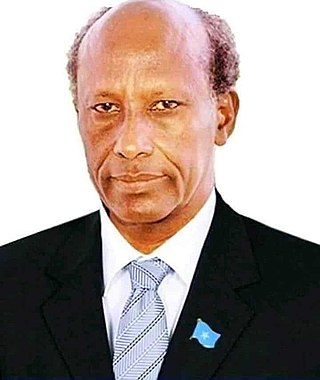
Mohamed Farrah Hassan Aidid was a Somali general and diplomat.

Mohamed Siad Barre was a Somali head of state and general who served as the 3rd president of the Somali Democratic Republic from 1969 to 1991. He was given the childhood nickname Barre roughly referring to extraversion. Barre, a major general of the gendarmerie by profession, became President of Somalia after the 1969 coup d'état that overthrew the Somali Republic following the assassination of President Abdirashid Shermarke. The Supreme Revolutionary Council military junta under Barre reconstituted Somalia as a one-party Marxist–Leninist communist state, renamed the country the Somali Democratic Republic and adopted scientific socialism.

The Somali Democratic Republic was the name that the socialist military government gave to Somalia under President Major General Mohamed Siad Barre, after seizing power in a coup d'état on 21 October 1969. The coup came a few days after a bodyguard assassinated Abdirashid Shermarke, the nation's second President. Barre's administration ruled Somalia for the next 21 years until Somalia collapsed into civil war in 1991.
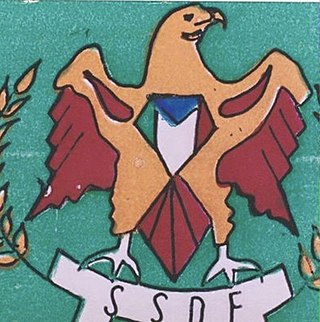
Somali Salvation Democratic Front (SSDF) (Somali: Jabhadda Diimuqraadiga Badbaadinta Soomaaliyeed), initially known as the Democratic Front for Salvation of Somalia, was a political and paramilitary umbrella organization in Somalia. Founded in 1978 by several army officers, it was the first of several opposition groups dedicated to ousting the authoritarian regime of Mohamed Siad Barre. With its power base mainly in the Majeerteen clan, SSDF representatives, along with local elders, intellectuals and business people, were instrumental in the establishment in 1998 of the autonomous Puntland state in northeastern Somalia.

Abdullahi Yusuf Ahmed was a Somali politician and former colonel in the Somali National Army. He was one of the founders of the Somali Salvation Democratic Front, as well as the Puntland state of Somalia, the latter of which he served as the first president. In 2004, Ahmed also helped establish the Transitional Federal Government, which he led as President of Somalia from 2004 until 2008.
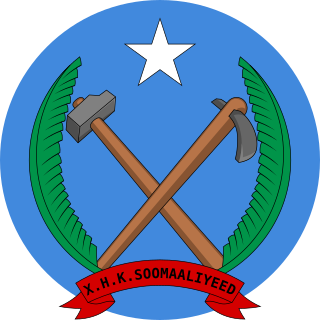
The Somali Revolutionary Socialist Party was the ruling party of the Somali Democratic Republic from 1976 to 1991.
The Majeerteen is a prominent Somali sub-clan of the Harti, which falls under the Darod clan. Traditionally, they inhabit extensive territories in the Bari, Nugaal, and Mudug regions of Somalia, spanning from Bosaso to Garacad, mainly in Puntland state. Additionally, Majeerteen populations are present in southern towns such as Kismayo.

The Ogaden War, also known as the Ethio-Somali War, was a military conflict fought between Somalia and Ethiopia from July 1977 to March 1978 over the Ethiopian region of Ogaden. Somalia's invasion of the region, precursor to the wider war, met with the Soviet Union's disapproval, leading the superpower to end its support of Somalia and support Ethiopia instead.
The United Somali Congress (USC) was one of the major rebel organizations in Somalia. Formed in 1989, it played a leading role in the ouster of the government of Siad Barre in 1991, and became a target of the Unified Task Force campaign in 1993. Following infighting, the USC later splintered into smaller groups. By 2000, with the establishment of a Transitional National Government (TNG), a process of disarmament was put in motion and some moderate ex-USC leaders were incorporated into the new interim administration.

Hirsi Magan Isse, commonly known as Hirsi Magan, was a scholar and a leading figure of the Somali revolution. Part of Somalia's political elite, he was a leader in the Somali Salvation Democratic Front (SSDF), one of the earliest and most influential factions in the Somali Civil War that broke out in 1991.
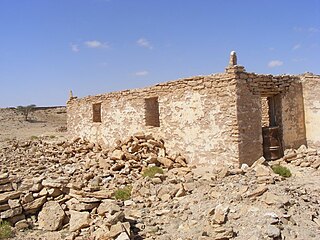
Harti, meaning "strong man", is a Somali clan family that is the part of the Darod clan. The major sub-clans include the Majeerteen, Dhulbahante, Warsangali, Tinle, Maganlabe, Kaptallah and Dishiishe, while other minor sub-clans consist of Kaskiqabe, Geesaguule and Liibaangashe.

The Somali National Movement was one of the first and most important organized guerilla groups opposed to the Siad Barre regime in the 1980s to the 1990s, as well as being the main anti-government faction during the Somaliland War of Independence. The organisation was founded in London, England, on April 6, 1981 by Ahmed Ismail Abdi ‘Duksi’, Hassan Isse Jama, Abdisalam Yasin, Hassan Adan Wadadid, a former Somali diplomat, who stated that the group's purpose was to overthrow the Siad Barre regime.
Following the civil war and the ensuing societal chaos, some factions managed to exert a degree of authority over certain regions of Somalia where they maintained broad, clan-based support. This allowed these factions to establish working administrations and eventually coherent states, and restored order to their regions. This occurred first in Puntland, Southwestern Somalia, Galmudug, Jubaland and finally Banadir.
The Somali Rebellion was the beginning of the civil war in Somalia that occurred in the 1980s and early 1990s. The rebellion started in 1978 when President Siad Barre began using his special forces, the "Red Berets", to attack clan-based dissident groups opposed to his regime. The dissidents had been becoming more powerful for nearly a decade following his abrupt switch of allegiance from the Soviet Union to the United States and the disastrous 1977-78 Ogaden War.
The Somali National Front (SNF) was a politico-military organization that operated in southern Somalia during the Somali Civil War and represented one of the major factions involved in the conflict.
Over the course of the Somali Civil War, there have been many revolutionary movements and militia groups run by competing rebel leaders which have held de facto control over vast areas within Somalia.
Osman Mahmoud is a Somali sub-clan. Is one of the larger sub-clans within the major Majeerteen Harti confederation of Darod clans. The sub-clan is most notorious for its rich history within Somalia, That of which include sultanates such as the Majeerteen Sultanate.
The 1982 Ethiopian–Somali Border War occurred between June and August 1982 when Ethiopia, sending a 10,000 man invasion force backed by warplanes and armored units, supported by thousands of SSDF rebels invaded Central Somalia. The United States government responded by speeding up deliveries of light arms and main battle tanks already promised. In addition, the initially pledged US$45 million in economic and military aid was increased to US$80 million.
Dr. Hassan Ali Mire, also known as Hasaan ‘Ali Mirreh, was a Somali politician. During the early 1970s, he briefly served as the first Minister of Education of the Somali Democratic Republic. Mire later co-founded and chaired the Somali Salvation Democratic Front (SSDF). In 1998, he was also among the founders of the autonomous Puntland State of Somalia.
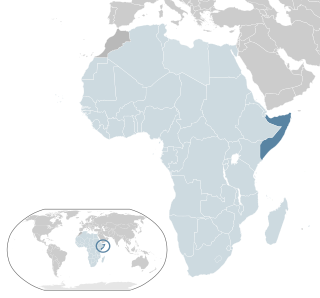
The 1978 Somali coup d'état attempt was a violent military coup attempt that took place in Somalia on 9 April 1978, against the regime of President Siad Barre. The United States Central Intelligence Agency estimated that the coup, led by Colonel Mohamed Osman Irro, involved around 24 officers, 2,000 soldiers, and 65 tanks. Following the failed coup, 17 alleged ringleaders, including Osman, were summarily executed by firing squad.
References
- ↑ Bereketeab, Redie (2017). National Liberation Movements as Government in Africa. Taylor & Francis. p. 15. ISBN 9781351588836.
- ↑ Ingiriis, Mohamed Haji (2017). The Suicidal State in Somalia;. UPA. p. 105. ISBN 9780761867203.